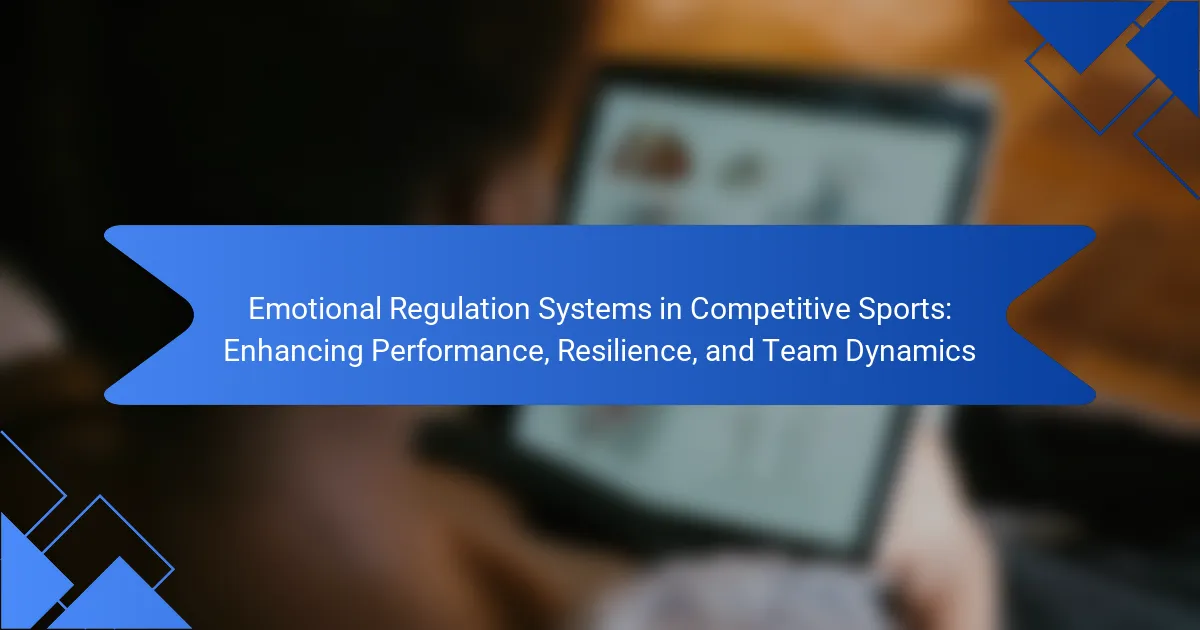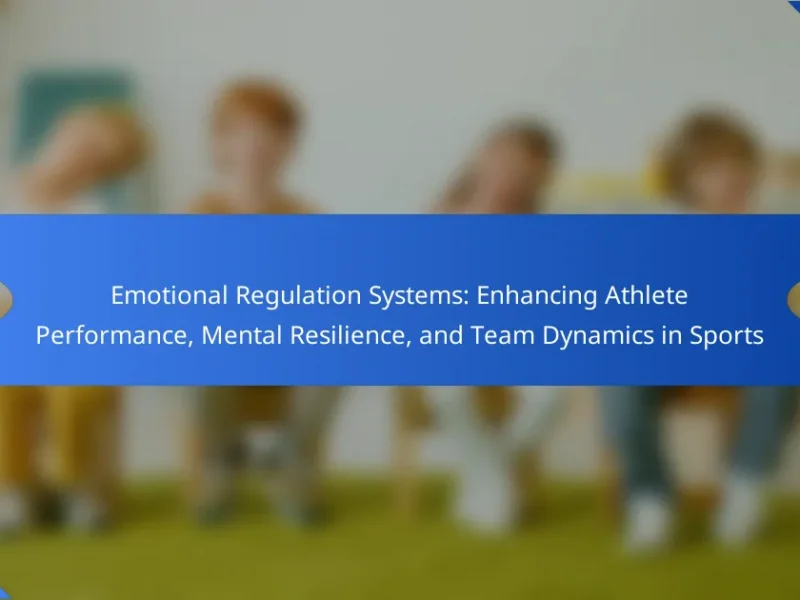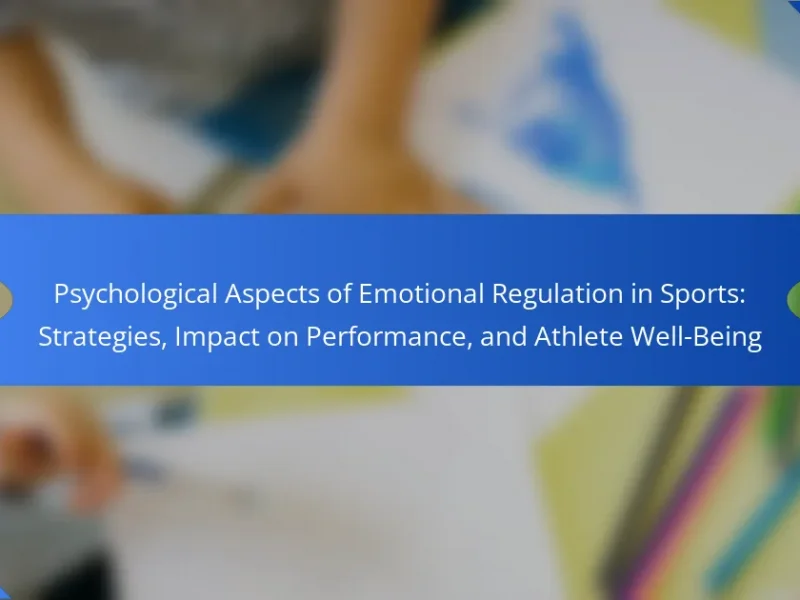Emotional regulation systems are essential for athletes aiming to enhance performance and resilience while improving team dynamics. These systems help manage emotions during high-pressure situations, leading to better focus and decision-making. Techniques such as mindfulness and cognitive restructuring are effective tools for fostering emotional awareness and adaptability. Research shows that teams prioritising emotional regulation experience increased cohesion and communication, contributing to overall success in competitive sports.
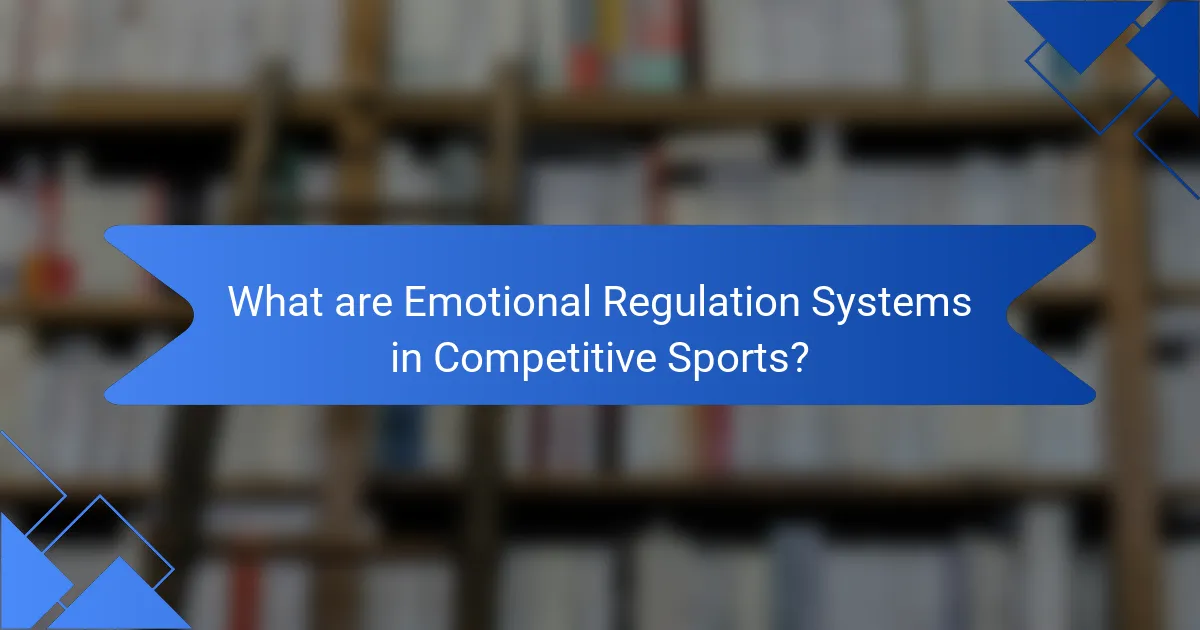
What are Emotional Regulation Systems in Competitive Sports?
Emotional regulation systems in competitive sports are crucial for enhancing performance, resilience, and team dynamics. These systems help athletes manage their emotions effectively, leading to improved focus and competitive edge.
Athletes utilise various techniques such as mindfulness, cognitive restructuring, and emotional awareness to regulate their emotions during high-pressure situations. Research indicates that effective emotional regulation can lead to a 20% increase in performance metrics.
Moreover, these systems foster resilience by enabling athletes to bounce back from setbacks. Teams that prioritise emotional regulation often experience better cohesion and communication, enhancing overall dynamics.
In summary, emotional regulation systems are essential for athletes, contributing to improved performance, resilience, and stronger team dynamics.
How do Emotional Regulation Systems impact athlete performance?
Emotional Regulation Systems significantly enhance athlete performance by improving focus, resilience, and team dynamics. Effective emotional regulation allows athletes to manage stress and anxiety, leading to better decision-making during competitions. Research indicates that athletes with strong emotional regulation skills exhibit higher levels of motivation and perseverance, directly correlating with improved performance metrics. Additionally, these systems foster better communication and collaboration within teams, creating a supportive environment that enhances overall dynamics.
What role does emotional regulation play in team dynamics?
Emotional regulation significantly enhances team dynamics by fostering communication, collaboration, and resilience. Effective emotional regulation allows team members to manage stress and conflict, leading to improved performance. Research shows that teams with strong emotional regulation skills exhibit higher levels of trust and cohesion, which are critical for success in competitive sports. As a result, athletes can focus on their roles, support one another, and maintain a positive atmosphere, ultimately enhancing overall team performance.

What are the universal attributes of Emotional Regulation Systems in sports?
Emotional Regulation Systems in sports enhance performance through managing emotions, fostering resilience, and improving team dynamics. Key attributes include awareness, control, adaptability, and social support. Awareness allows athletes to identify emotional triggers. Control involves techniques to modulate emotions effectively. Adaptability enables quick responses to changing situations. Social support strengthens team cohesion and emotional resilience. These attributes collectively drive better decision-making and performance outcomes in competitive environments.
How do athletes commonly express emotions during competition?
Athletes commonly express emotions during competition through body language, vocalisations, and interactions with teammates. These expressions significantly impact their performance and team dynamics.
Body language includes gestures, facial expressions, and posture, which can convey confidence or anxiety. Vocalisations, such as shouting or encouraging teammates, serve to motivate and energise. Interactions with teammates reflect emotional states and can foster resilience and unity.
Research indicates that emotional regulation is crucial for enhancing performance. Athletes who effectively manage their emotions often demonstrate improved focus and resilience under pressure. This regulation also influences team dynamics, promoting a supportive environment that enhances overall performance.
What techniques are universally used for emotional regulation?
Cognitive restructuring, mindfulness practices, and emotional awareness are universally used techniques for emotional regulation. These methods help athletes manage emotions, enhancing performance and resilience in competitive sports. Cognitive restructuring involves reframing negative thoughts, while mindfulness promotes present-moment awareness. Emotional awareness enables athletes to identify and understand their feelings, leading to better control over emotional responses.
How does emotional awareness contribute to performance?
Emotional awareness significantly enhances performance by enabling athletes to manage stress and maintain focus. It fosters resilience, allowing individuals to bounce back from setbacks. Additionally, it improves team dynamics through better communication and empathy, leading to more cohesive collaboration. Emotional regulation systems empower athletes to harness their emotions constructively, ultimately contributing to superior competitive outcomes.

What unique attributes distinguish Emotional Regulation Systems in major sports?
Unique attributes of Emotional Regulation Systems in major sports include adaptability, team cohesion, and mental resilience. These systems enhance performance by providing athletes with tools to manage stress and anxiety. Adaptability allows athletes to adjust their emotional responses during competition, which is crucial for maintaining focus. Team cohesion fosters a supportive environment, enhancing collective emotional regulation. Mental resilience, a unique attribute, empowers athletes to recover from setbacks quickly, maintaining peak performance levels.
How do specific sports implement tailored emotional regulation strategies?
Competitive sports implement tailored emotional regulation strategies to enhance performance and team dynamics. For instance, basketball teams utilise mindfulness techniques to improve focus during high-pressure moments. Soccer players often engage in visualisation practices to manage anxiety before matches.
Additionally, sports psychologists work with athletes to develop coping mechanisms for stress, fostering resilience. Techniques like breathing exercises and positive self-talk are common across various sports, aiding athletes in maintaining composure.
Research shows that these strategies not only improve individual performance but also strengthen team cohesion. Implementing emotional regulation systems can lead to better communication and collaboration among team members, ultimately enhancing overall outcomes in competitions.
What are the unique challenges faced by athletes in high-pressure environments?
Athletes in high-pressure environments face unique challenges, including heightened anxiety, intense competition, and the need for rapid emotional regulation. These factors can negatively impact performance and team dynamics. Emotional regulation systems are crucial for managing stress and maintaining focus. For instance, techniques like mindfulness and visualisation can enhance resilience and decision-making under pressure. Additionally, the ability to cope with external expectations and internal pressures is vital for sustained success in competitive sports.

What rare attributes are associated with Emotional Regulation Systems?
Emotional Regulation Systems in competitive sports exhibit rare attributes such as adaptive flexibility, which allows athletes to adjust their emotional responses based on situational demands. Another rare attribute is meta-emotional awareness, enabling athletes to understand and manage their emotional states effectively. These attributes enhance performance by fostering resilience and improving team dynamics.
How do elite athletes utilise advanced emotional regulation techniques?
Elite athletes utilise advanced emotional regulation techniques to enhance focus, manage stress, and improve overall performance. Techniques such as mindfulness, visualisation, and cognitive restructuring allow athletes to maintain composure under pressure. For example, mindfulness practices help athletes stay present, reducing anxiety and increasing concentration during competitions. Visualisation techniques enable athletes to mentally rehearse successful performances, reinforcing confidence and reducing negative self-talk. Cognitive restructuring allows athletes to reframe negative thoughts, fostering resilience and a positive mindset. These approaches contribute to improved team dynamics by promoting emotional intelligence and effective communication among team members.
What uncommon practices have emerged in emotional regulation training?
Uncommon practices in emotional regulation training include mindfulness-based interventions, biofeedback techniques, and narrative therapy approaches. These methods enhance athletes’ self-awareness and emotional control, fostering resilience and improving team dynamics. For instance, mindfulness practices help athletes stay present and manage stress effectively. Biofeedback allows individuals to monitor physiological responses, promoting regulation strategies tailored to their unique emotional states. Narrative therapy encourages athletes to reframe their experiences, enhancing emotional resilience through storytelling.
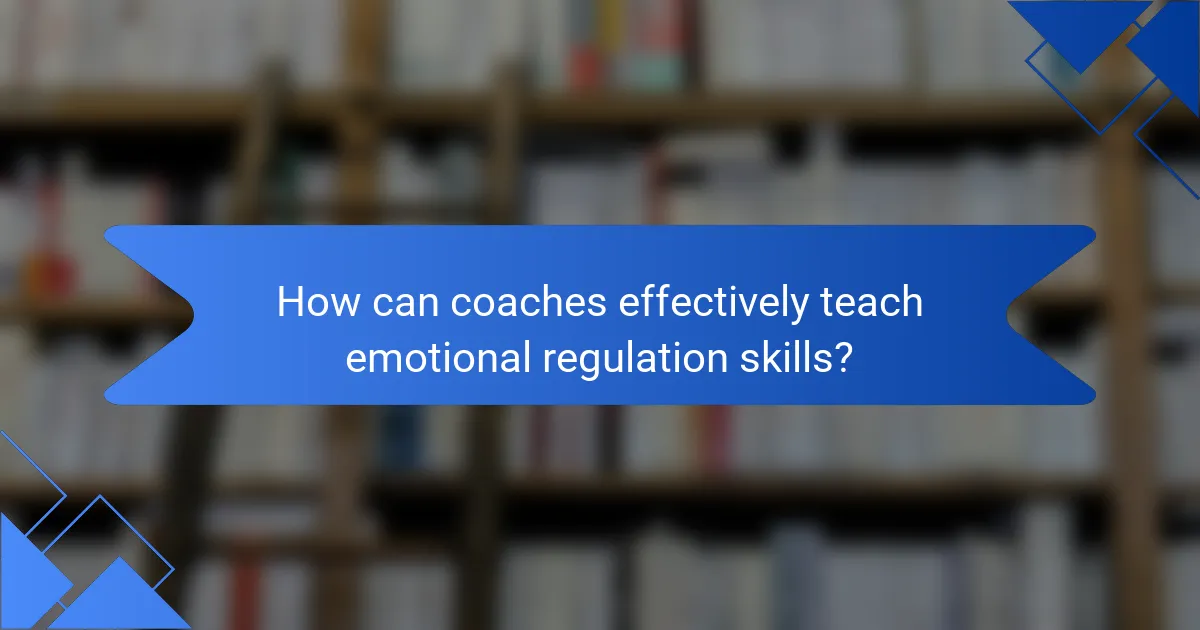
How can coaches effectively teach emotional regulation skills?
Coaches can effectively teach emotional regulation skills by integrating structured practices into training sessions. Techniques such as mindfulness, cognitive restructuring, and emotional awareness exercises enhance athletes’ self-regulation.
Mindfulness practices, like breathing exercises, help athletes stay present and manage stress. Cognitive restructuring teaches athletes to reframe negative thoughts, fostering resilience. Emotional awareness exercises encourage athletes to identify and express their feelings, improving team dynamics.
Implementing these strategies consistently can lead to improved performance and stronger interpersonal relationships within the team. Coaches should prioritise emotional regulation as a core component of training to cultivate a supportive environment.
What are best practices for integrating emotional regulation into training programs?
Integrating emotional regulation into training programs enhances athletes’ performance and resilience. Effective practices include teaching mindfulness techniques, promoting open communication, and incorporating scenario-based training.
Mindfulness techniques help athletes manage stress and improve focus. Open communication fosters a supportive environment, allowing team members to express emotions constructively. Scenario-based training prepares athletes for high-pressure situations, enhancing their emotional responses during competitions.
Regular assessment of emotional regulation skills can identify areas for improvement. Coaches should provide feedback and encourage self-reflection to reinforce these skills.
Incorporating these practices creates a culture of emotional awareness, ultimately benefiting team dynamics and overall performance.
What common mistakes do coaches make regarding emotional regulation?
Coaches often overlook the importance of emotional regulation, leading to common mistakes. They may neglect to teach athletes effective coping strategies, resulting in heightened stress during competitions. Additionally, failing to model emotional awareness can create an environment where athletes struggle to express their feelings. Coaches might also misinterpret emotional responses, leading to inappropriate reactions that can damage team dynamics. Lastly, not providing adequate support during emotional challenges can hinder athletes’ resilience and overall performance.

How can athletes develop their emotional regulation skills?
Athletes can develop emotional regulation skills through targeted training and practice. Techniques like mindfulness, cognitive restructuring, and controlled breathing enhance emotional awareness and response. Regularly practicing these techniques fosters resilience and improves performance under pressure. Team dynamics also benefit, as emotional regulation promotes better communication and cooperation among athletes.
What actionable strategies can athletes adopt for better emotional control?
Athletes can enhance emotional control through mindfulness practices, cognitive restructuring, and effective communication. Mindfulness techniques, such as deep breathing and meditation, help athletes stay present and reduce anxiety. Cognitive restructuring involves identifying negative thoughts and replacing them with positive affirmations, fostering a resilient mindset. Effective communication within teams promotes trust and emotional support, contributing to better emotional regulation. These strategies collectively improve performance and team dynamics.
How can mindfulness practices enhance emotional regulation?
Mindfulness practices enhance emotional regulation by fostering self-awareness and reducing stress. These techniques help athletes manage their emotions, improving focus and performance. Research indicates that mindfulness increases resilience, enabling better responses to pressure and setbacks. Additionally, it promotes positive team dynamics through improved communication and empathy.
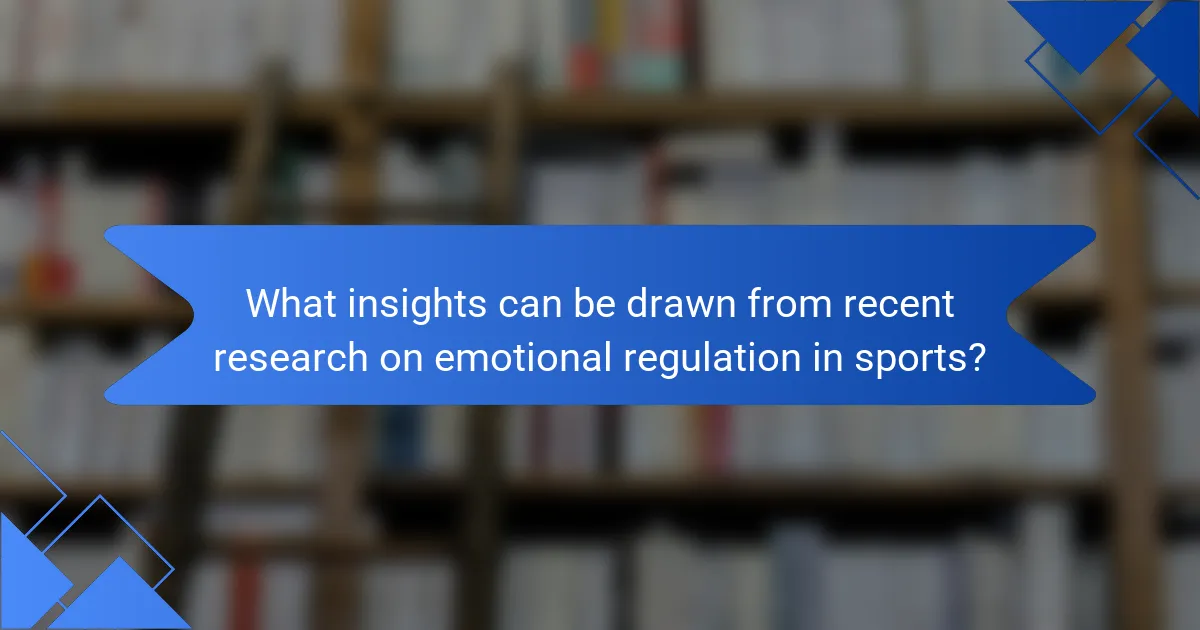
What insights can be drawn from recent research on emotional regulation in sports?
Recent research highlights that effective emotional regulation systems significantly enhance performance, resilience, and team dynamics in competitive sports. Athletes who master emotional control can maintain focus under pressure, leading to improved decision-making and execution. Studies indicate that teams with strong emotional regulation capabilities show higher cohesion and better conflict resolution. Furthermore, athletes utilising techniques like mindfulness and cognitive restructuring report increased resilience, enabling them to bounce back from setbacks more efficiently. Overall, emotional regulation emerges as a critical factor in achieving sustained success in sports.
What are the implications of emotional regulation research for future athlete training?
Emotional regulation research has profound implications for athlete training, enhancing performance and resilience. By understanding emotional regulation systems, coaches can develop tailored training programs that foster mental toughness and improve team dynamics.
Training that incorporates emotional regulation techniques can lead to better focus during competitions. Athletes who manage their emotions effectively are more likely to maintain composure under pressure, resulting in improved performance outcomes.
Moreover, integrating emotional regulation strategies can enhance resilience. Athletes trained in these techniques are better equipped to recover from setbacks and maintain motivation. This resilience contributes to long-term athletic development and success.
Finally, fostering emotional regulation within teams can strengthen team dynamics. Effective communication and emotional support among teammates lead to a more cohesive unit, improving overall performance in competitive settings.
How can emerging technologies support emotional regulation in sports?
Emerging technologies enhance emotional regulation in sports by providing real-time feedback and personalised strategies. Wearable devices monitor physiological signals, allowing athletes to recognise stress and anxiety levels. Virtual reality environments simulate competitive scenarios, enabling athletes to practice emotional responses. Mobile applications offer mindfulness and cognitive behavioural techniques tailored to individual needs, fostering resilience. Data analytics identifies patterns in emotional responses, helping coaches optimise team dynamics and performance.
